Abstract
A nested set of 11 overlapping synthetic peptides covering the entire sequence of rubella virus capsid protein was synthesized, purified, and tested against human rubella virus-specific T-cell lines and rubella virus-seropositive sera. T-cell lines derived from four donors responded strongly to four synthetic peptides containing residues 96 to 123, 119 to 152, 205 to 233, and 255 to 280. Only one peptide (residues 255 to 280) was recognized by all four T-cell lines. Two human immunodominant linear B-cell epitopes were mapped to residues 1 to 30 and 96 to 123 by using peptide-specific enzyme-linked immunosorbent assay. All 11 synthetic peptides were highly immunogenic and induced strong antibody responses in rabbits against the respective immunized peptides. Seven of the 11 rabbit antipeptide antisera (anti-1-30, -74-100, -96-123, -119-152, -205-233, -231-257, and -255-280) specifically recognized the capsid protein on immunoblots. Identification of these T- and B-cell epitopes represents the first step toward rational design of synthetic vaccines against rubella.
Full text
PDF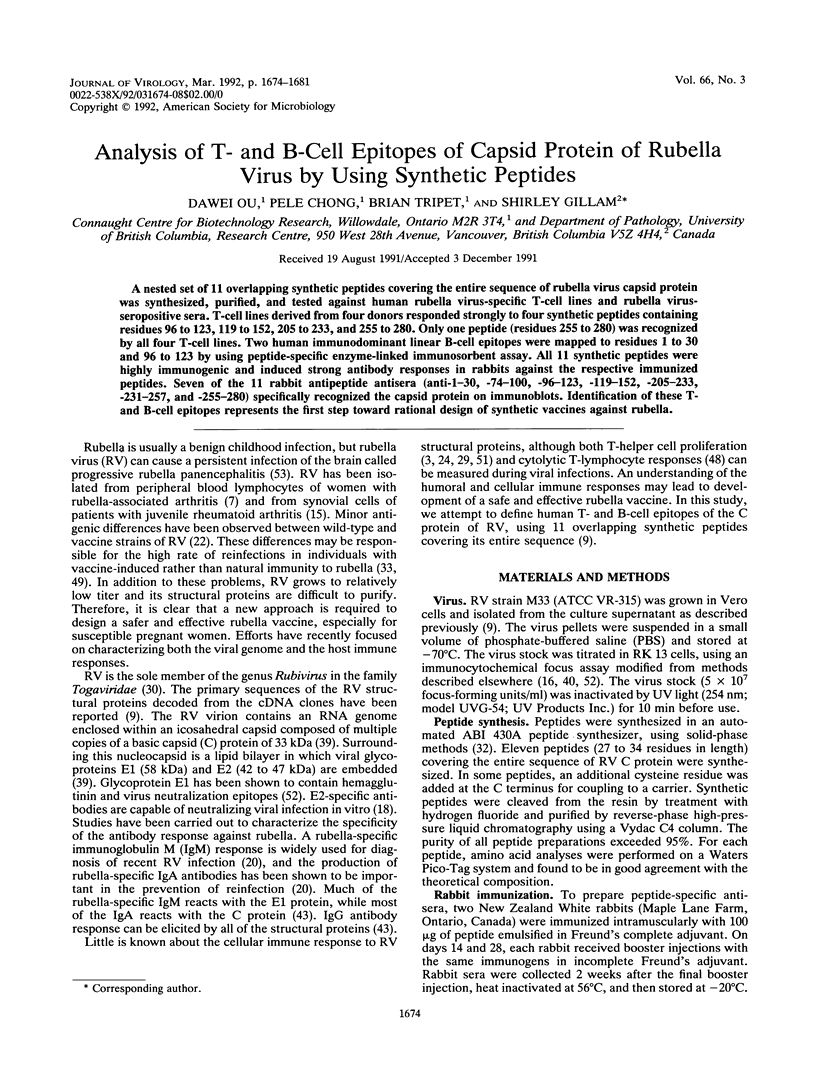
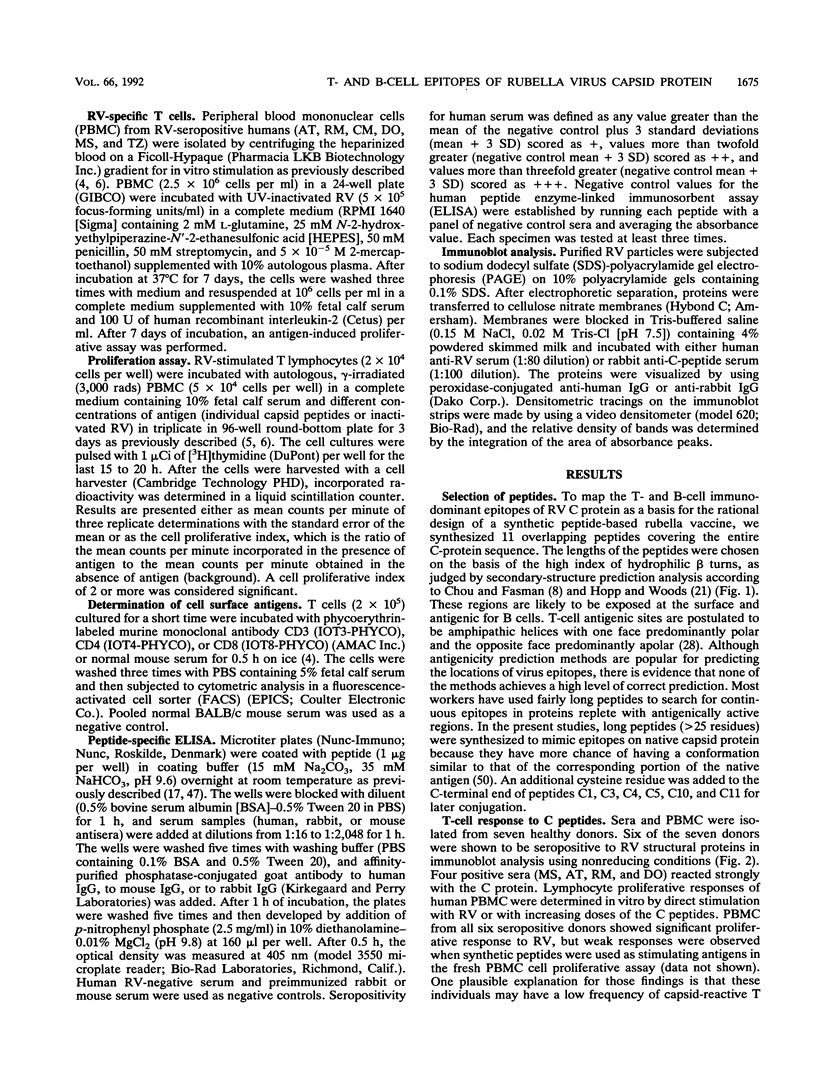
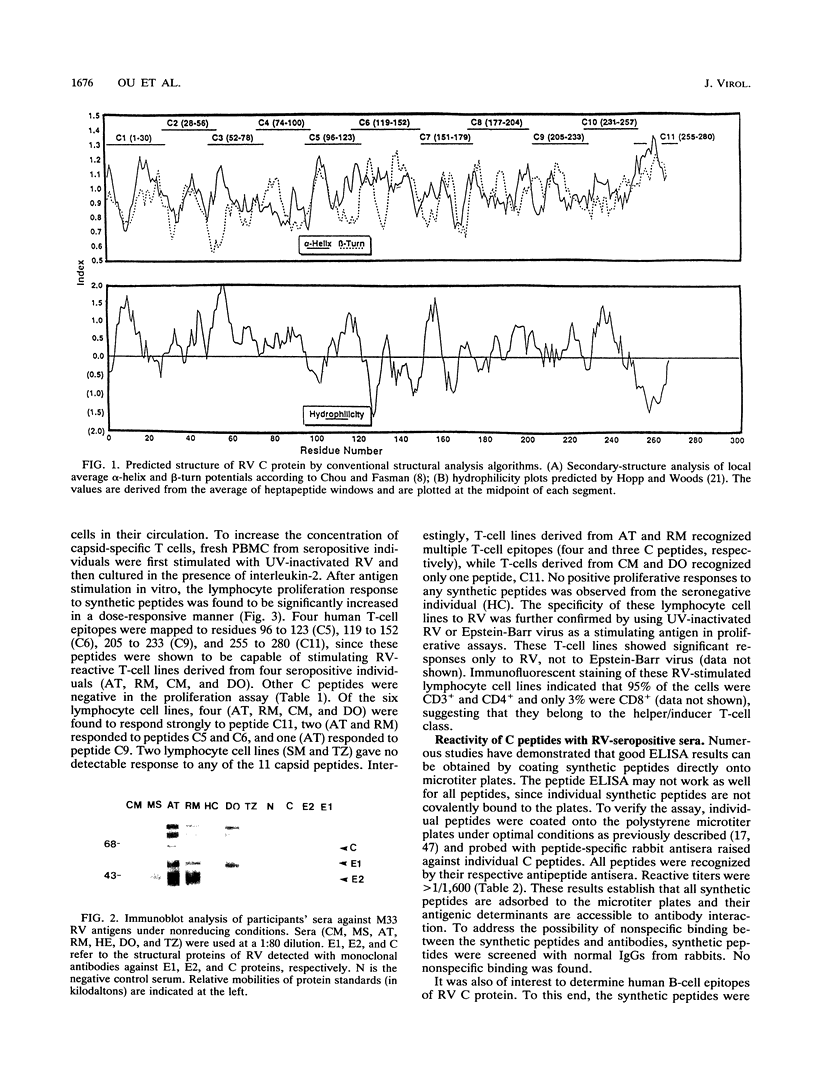
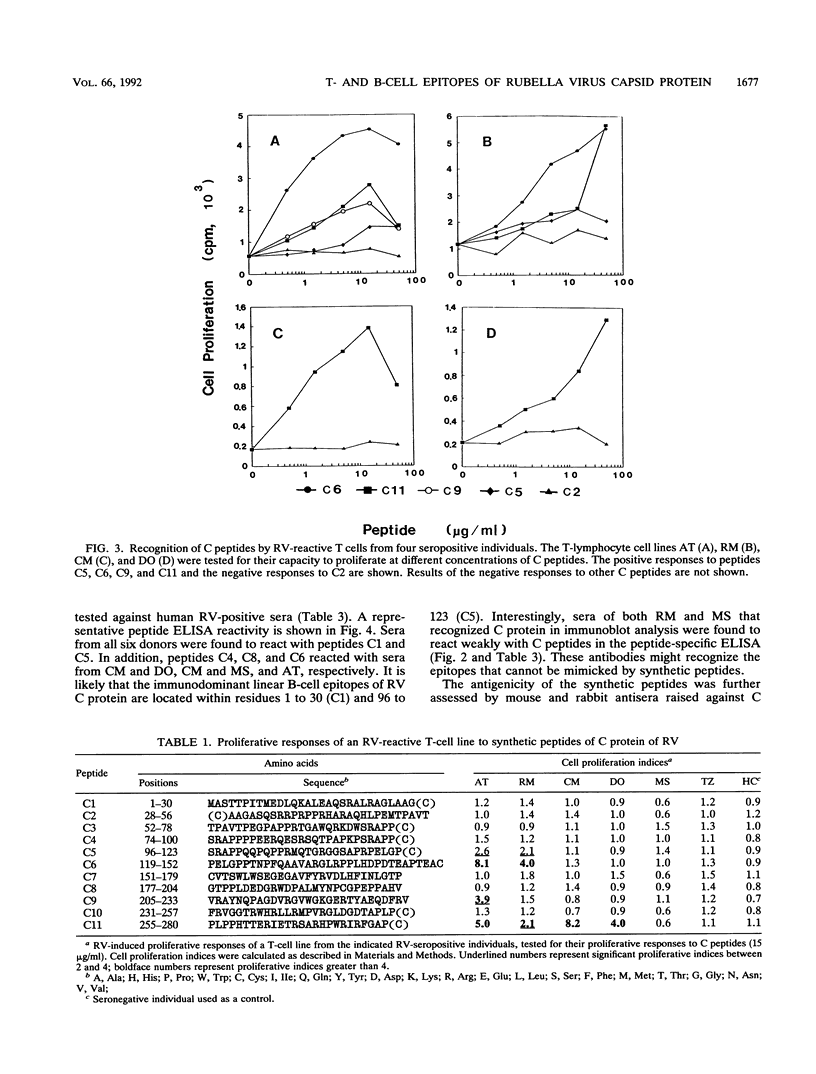
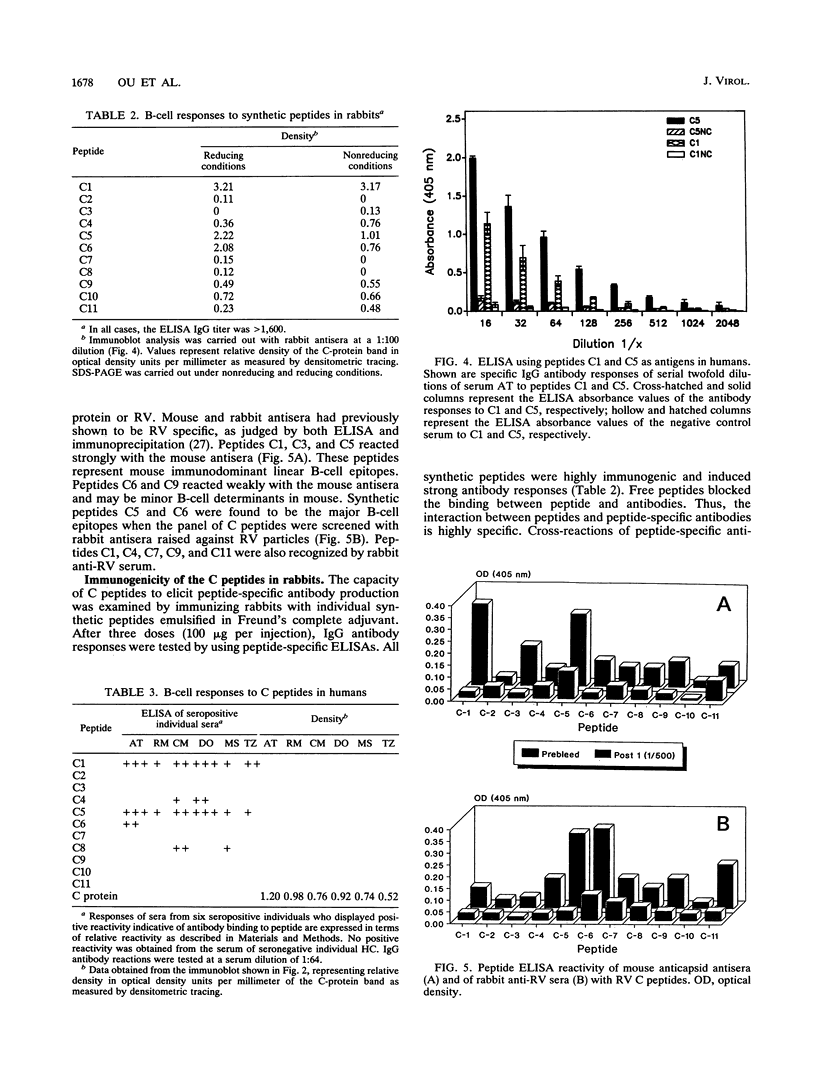
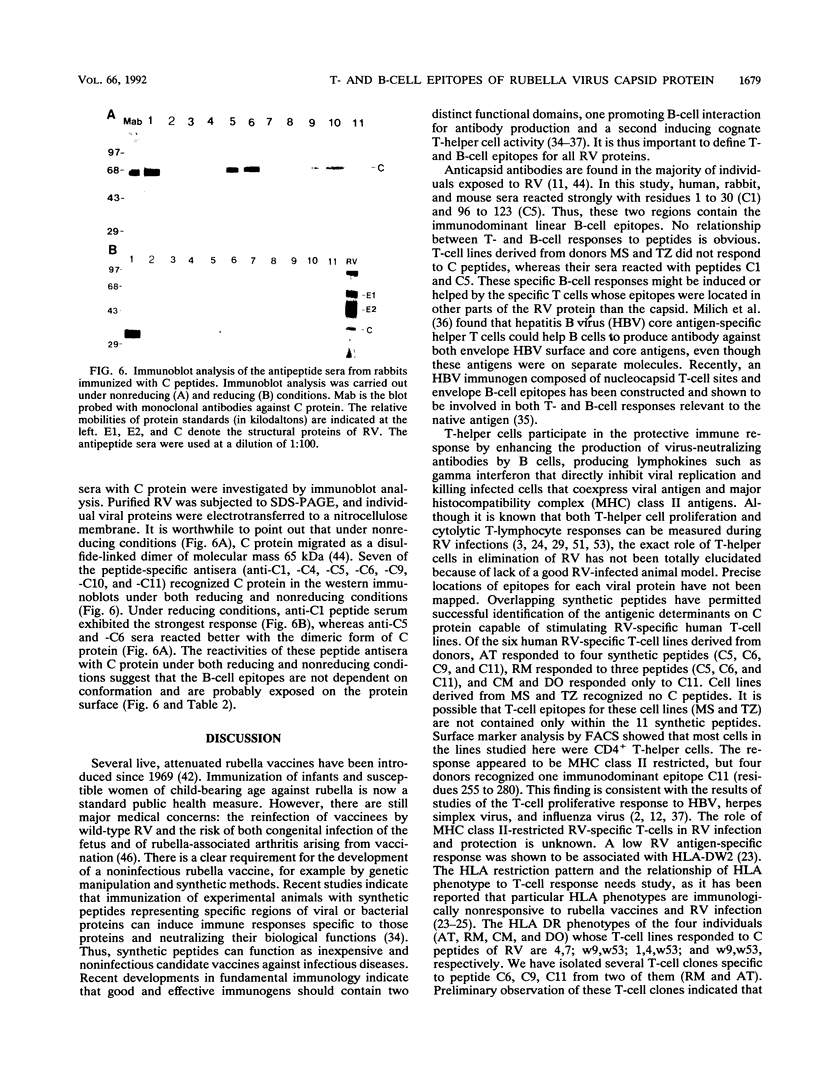
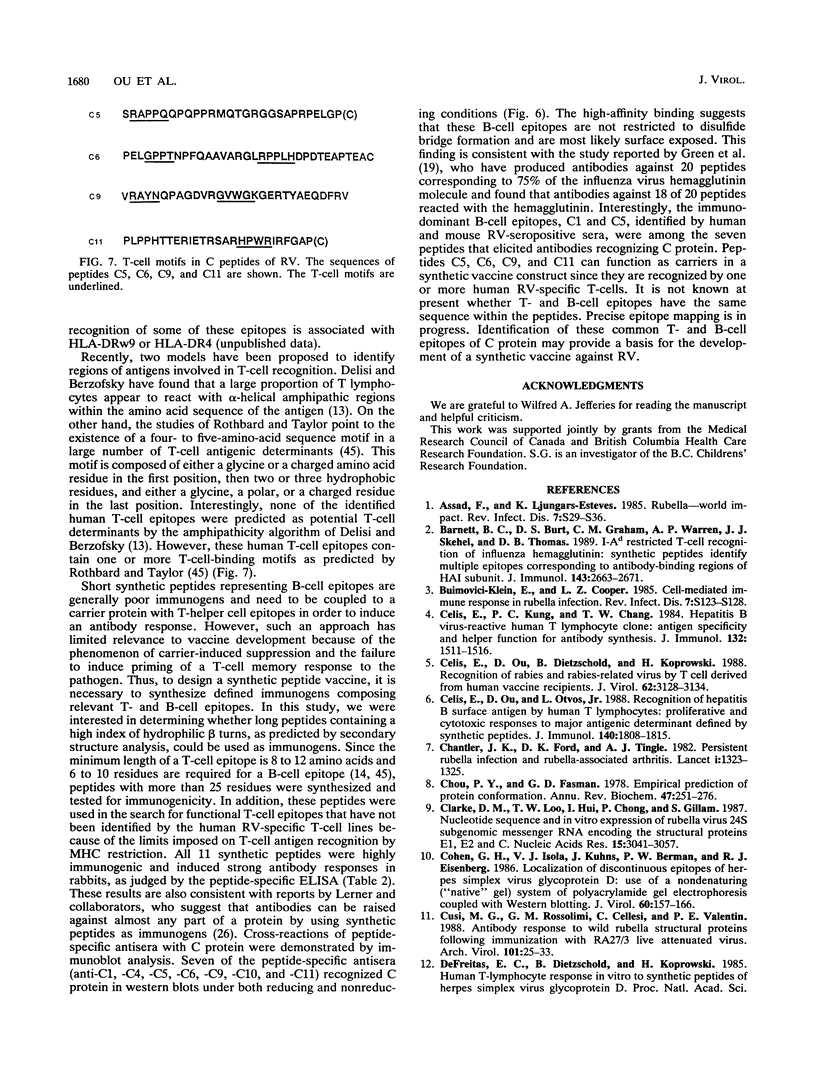
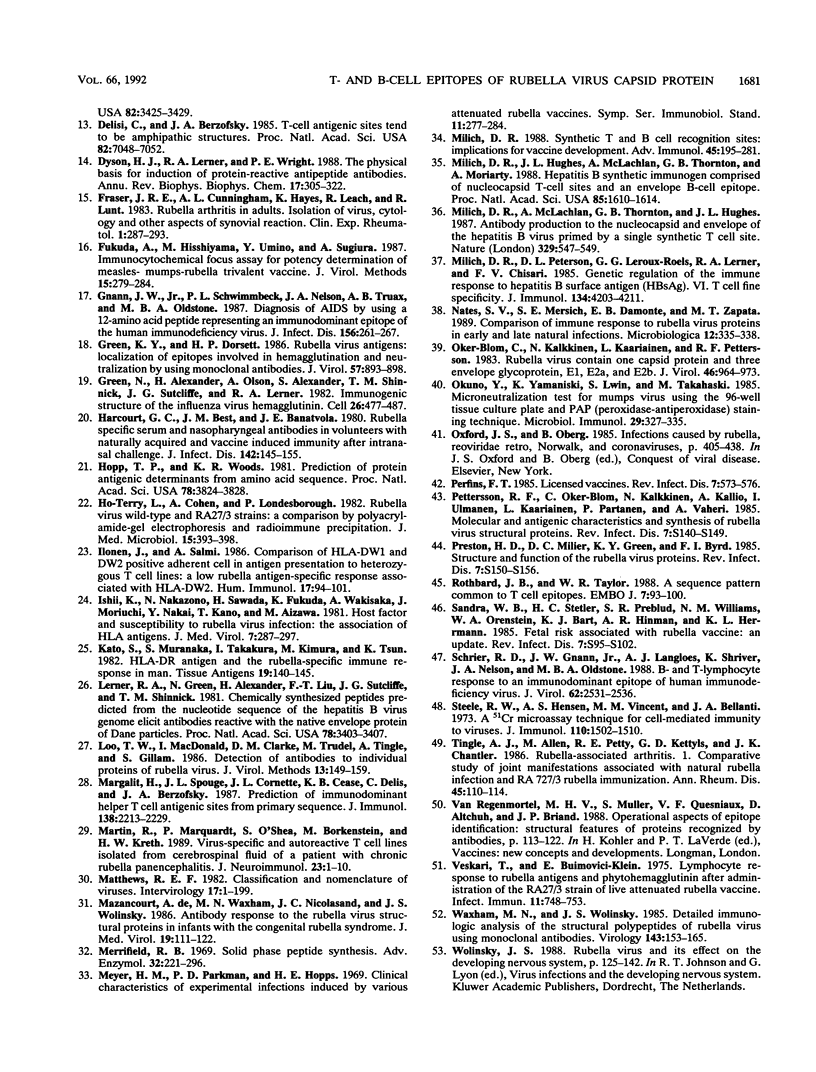
Images in this article
Selected References
These references are in PubMed. This may not be the complete list of references from this article.
- Assaad F., Ljungars-Esteves K. Rubella--world impact. Rev Infect Dis. 1985 Mar-Apr;7 (Suppl 1):S29–S36. doi: 10.1093/clinids/7.supplement_1.s29. [DOI] [PubMed] [Google Scholar]
- Barnett B. C., Burt D. S., Graham C. M., Warren A. P., Skehel J. J., Thomas D. B. I-Ad restricted T cell recognition of influenza hemagglutinin. Synthetic peptides identify multiple epitopes corresponding to antibody-binding regions of the HA1 subunit. J Immunol. 1989 Oct 15;143(8):2663–2669. [PubMed] [Google Scholar]
- Bart S. W., Stetler H. C., Preblud S. R., Williams N. M., Orenstein W. A., Bart K. J., Hinman A. R., Herrmann K. L. Fetal risk associated with rubella vaccine: an update. Rev Infect Dis. 1985 Mar-Apr;7 (Suppl 1):S95–102. doi: 10.1093/clinids/7.supplement_1.s95. [DOI] [PubMed] [Google Scholar]
- Buimovici-Klein E., Cooper L. Z. Cell-mediated immune response in rubella infections. Rev Infect Dis. 1985 Mar-Apr;7 (Suppl 1):S123–S128. doi: 10.1093/clinids/7.supplement_1.s123. [DOI] [PubMed] [Google Scholar]
- Celis E., Kung P. C., Chang T. W. Hepatitis B virus-reactive human T lymphocyte clones: antigen specificity and helper function for antibody synthesis. J Immunol. 1984 Mar;132(3):1511–1516. [PubMed] [Google Scholar]
- Celis E., Ou D., Dietzschold B., Koprowski H. Recognition of rabies and rabies-related viruses by T cells derived from human vaccine recipients. J Virol. 1988 Sep;62(9):3128–3134. doi: 10.1128/jvi.62.9.3128-3134.1988. [DOI] [PMC free article] [PubMed] [Google Scholar]
- Celis E., Ou D., Otvos L., Jr Recognition of hepatitis B surface antigen by human T lymphocytes. Proliferative and cytotoxic responses to a major antigenic determinant defined by synthetic peptides. J Immunol. 1988 Mar 15;140(6):1808–1815. [PubMed] [Google Scholar]
- Chantler J. K., Ford D. K., Tingle A. J. Persistent rubella infection and rubella-associated arthritis. Lancet. 1982 Jun 12;1(8285):1323–1325. doi: 10.1016/s0140-6736(82)92398-4. [DOI] [PubMed] [Google Scholar]
- Chou P. Y., Fasman G. D. Empirical predictions of protein conformation. Annu Rev Biochem. 1978;47:251–276. doi: 10.1146/annurev.bi.47.070178.001343. [DOI] [PubMed] [Google Scholar]
- Clarke D. M., Loo T. W., Hui I., Chong P., Gillam S. Nucleotide sequence and in vitro expression of rubella virus 24S subgenomic messenger RNA encoding the structural proteins E1, E2 and C. Nucleic Acids Res. 1987 Apr 10;15(7):3041–3057. doi: 10.1093/nar/15.7.3041. [DOI] [PMC free article] [PubMed] [Google Scholar]
- Classification and nomenclature of viruses. Fourth report of the International Committee on Taxonomy of Viruses. Intervirology. 1982;17(1-3):1–199. doi: 10.1159/000149278. [DOI] [PubMed] [Google Scholar]
- Cohen G. H., Isola V. J., Kuhns J., Berman P. W., Eisenberg R. J. Localization of discontinuous epitopes of herpes simplex virus glycoprotein D: use of a nondenaturing ("native" gel) system of polyacrylamide gel electrophoresis coupled with Western blotting. J Virol. 1986 Oct;60(1):157–166. doi: 10.1128/jvi.60.1.157-166.1986. [DOI] [PMC free article] [PubMed] [Google Scholar]
- Cusi M. G., Rossolini G. M., Cellesi C., Valensin P. E. Antibody response to wild rubella virus structural proteins following immunization with RA 27/3 live attenuated vaccine. Arch Virol. 1988;101(1-2):25–33. doi: 10.1007/BF01314649. [DOI] [PubMed] [Google Scholar]
- DeLisi C., Berzofsky J. A. T-cell antigenic sites tend to be amphipathic structures. Proc Natl Acad Sci U S A. 1985 Oct;82(20):7048–7052. doi: 10.1073/pnas.82.20.7048. [DOI] [PMC free article] [PubMed] [Google Scholar]
- Dorsett P. H., Miller D. C., Green K. Y., Byrd F. I. Structure and function of the rubella virus proteins. Rev Infect Dis. 1985 Mar-Apr;7 (Suppl 1):S150–S156. doi: 10.1093/clinids/7.supplement_1.s150. [DOI] [PubMed] [Google Scholar]
- Dyson H. J., Lerner R. A., Wright P. E. The physical basis for induction of protein-reactive antipeptide antibodies. Annu Rev Biophys Biophys Chem. 1988;17:305–324. doi: 10.1146/annurev.bb.17.060188.001513. [DOI] [PubMed] [Google Scholar]
- Fraser J. R., Cunningham A. L., Hayes K., Leach R., Lunt R. Rubella arthritis in adults. Isolation of virus, cytology and other aspects of the synovial reaction. Clin Exp Rheumatol. 1983 Oct-Dec;1(4):287–293. [PubMed] [Google Scholar]
- Fukuda A., Hishiyama M., Umino Y., Sugiura A. Immunocytochemical focus assay for potency determination of measles-mumps-rubella trivalent vaccine. J Virol Methods. 1987 Mar;15(4):279–284. doi: 10.1016/0166-0934(87)90150-9. [DOI] [PubMed] [Google Scholar]
- Gnann J. W., Jr, Schwimmbeck P. L., Nelson J. A., Truax A. B., Oldstone M. B. Diagnosis of AIDS by using a 12-amino acid peptide representing an immunodominant epitope of the human immunodeficiency virus. J Infect Dis. 1987 Aug;156(2):261–267. doi: 10.1093/infdis/156.2.261. [DOI] [PubMed] [Google Scholar]
- Green K. Y., Dorsett P. H. Rubella virus antigens: localization of epitopes involved in hemagglutination and neutralization by using monoclonal antibodies. J Virol. 1986 Mar;57(3):893–898. doi: 10.1128/jvi.57.3.893-898.1986. [DOI] [PMC free article] [PubMed] [Google Scholar]
- Green N., Alexander H., Olson A., Alexander S., Shinnick T. M., Sutcliffe J. G., Lerner R. A. Immunogenic structure of the influenza virus hemagglutinin. Cell. 1982 Mar;28(3):477–487. doi: 10.1016/0092-8674(82)90202-1. [DOI] [PubMed] [Google Scholar]
- Harcourt G. C., Best J. M., Banatvala J. E. Rubella-specific serum and nasopharyngeal antibodies in volunteers with naturally acquired and vaccine-induced immunity after intranasal challenge. J Infect Dis. 1980 Aug;142(2):145–155. doi: 10.1093/infdis/142.2.145. [DOI] [PubMed] [Google Scholar]
- Ho-Terry L., Cohen A., Londesborough P. Rubella virus wild-type and RA27/3 strains: a comparison by polyacrylamide-gel electrophoresis and radioimmune precipitation. J Med Microbiol. 1982 Aug;15(3):393–398. doi: 10.1099/00222615-15-3-393. [DOI] [PubMed] [Google Scholar]
- Hopp T. P., Woods K. R. Prediction of protein antigenic determinants from amino acid sequences. Proc Natl Acad Sci U S A. 1981 Jun;78(6):3824–3828. doi: 10.1073/pnas.78.6.3824. [DOI] [PMC free article] [PubMed] [Google Scholar]
- Ilonen J., Salmi A. Comparison of HLA-Dw1 and -Dw2 positive adherent cells in antigen presentation to heterozygous T-cell lines: a low rubella antigen-specific response associated with HLA-Dw2. Hum Immunol. 1986 Oct;17(2):94–101. doi: 10.1016/0198-8859(86)90079-0. [DOI] [PubMed] [Google Scholar]
- Ishii K., Nakazono N., Sawada H., Fukuda K., Wakisaka A., Moriuchi J., Nakai Y., Kano T., Aizawa M. Host factors and susceptibility to rubella virus infection: the association of HLA antigens. J Med Virol. 1981;7(4):287–297. doi: 10.1002/jmv.1890070405. [DOI] [PubMed] [Google Scholar]
- Kato S., Muranaka S., Takakura I., Kimura M., Tsuji K. HLA-DR antigens and the rubella-specific immune response in man. Tissue Antigens. 1982 Feb;19(2):140–145. doi: 10.1111/j.1399-0039.1982.tb01430.x. [DOI] [PubMed] [Google Scholar]
- Lerner R. A., Green N., Alexander H., Liu F. T., Sutcliffe J. G., Shinnick T. M. Chemically synthesized peptides predicted from the nucleotide sequence of the hepatitis B virus genome elicit antibodies reactive with the native envelope protein of Dane particles. Proc Natl Acad Sci U S A. 1981 Jun;78(6):3403–3407. doi: 10.1073/pnas.78.6.3403. [DOI] [PMC free article] [PubMed] [Google Scholar]
- Loo T. W., MacDonald I., Clarke D. M., Trudel M., Tingle A., Gilam S. Detection of antibodies to individual proteins of rubella virus. J Virol Methods. 1986 May;13(2):149–159. doi: 10.1016/0166-0934(86)90083-2. [DOI] [PubMed] [Google Scholar]
- Margalit H., Spouge J. L., Cornette J. L., Cease K. B., Delisi C., Berzofsky J. A. Prediction of immunodominant helper T cell antigenic sites from the primary sequence. J Immunol. 1987 Apr 1;138(7):2213–2229. [PubMed] [Google Scholar]
- Martin R., Marquardt P., O'Shea S., Borkenstein M., Kreth H. W. Virus-specific and autoreactive T cell lines isolated from cerebrospinal fluid of a patient with chronic rubella panencephalitis. J Neuroimmunol. 1989 Jun;23(1):1–10. doi: 10.1016/0165-5728(89)90065-9. [DOI] [PMC free article] [PubMed] [Google Scholar]
- Merrifield R. B. Solid-phase peptide synthesis. Adv Enzymol Relat Areas Mol Biol. 1969;32:221–296. doi: 10.1002/9780470122778.ch6. [DOI] [PubMed] [Google Scholar]
- Milich D. R., Hughes J. L., McLachlan A., Thornton G. B., Moriarty A. Hepatitis B synthetic immunogen comprised of nucleocapsid T-cell sites and an envelope B-cell epitope. Proc Natl Acad Sci U S A. 1988 Mar;85(5):1610–1614. doi: 10.1073/pnas.85.5.1610. [DOI] [PMC free article] [PubMed] [Google Scholar]
- Milich D. R., McLachlan A., Thornton G. B., Hughes J. L. Antibody production to the nucleocapsid and envelope of the hepatitis B virus primed by a single synthetic T cell site. Nature. 1987 Oct 8;329(6139):547–549. doi: 10.1038/329547a0. [DOI] [PubMed] [Google Scholar]
- Milich D. R., Peterson D. L., Leroux-Roels G. G., Lerner R. A., Chisari F. V. Genetic regulation of the immune response to hepatitis B surface antigen (HBsAg). VI. T cell fine specificity. J Immunol. 1985 Jun;134(6):4203–4211. [PubMed] [Google Scholar]
- Nates S. V., Mersich S. E., Damonte E. B., Zapata M. T. Comparison of immune response to rubella virus proteins in early and late natural infections. Microbiologica. 1989 Oct;12(4):335–338. [PubMed] [Google Scholar]
- Oker-Blom C., Kalkkinen N., Käriäinen L., Pettersson R. F. Rubella virus contains one capsid protein and three envelope glycoproteins, E1, E2a, and E2b. J Virol. 1983 Jun;46(3):964–973. doi: 10.1128/jvi.46.3.964-973.1983. [DOI] [PMC free article] [PubMed] [Google Scholar]
- Okuno Y., Yamanishi K., Lwin S., Takahashi M. Micro-neutralization test for mumps virus using the 96-well tissue culture plate and PAP (peroxidase-antiperoxidase) staining technique. Microbiol Immunol. 1985;29(4):327–335. doi: 10.1111/j.1348-0421.1985.tb00831.x. [DOI] [PubMed] [Google Scholar]
- Pettersson R. F., Oker-Blom C., Kalkkinen N., Kallio A., Ulmanen I., Käriäinen L., Partanen P., Vaheri A. Molecular and antigenic characteristics and synthesis of rubella virus structural proteins. Rev Infect Dis. 1985 Mar-Apr;7 (Suppl 1):S140–S149. doi: 10.1093/clinids/7.supplement_1.s140. [DOI] [PubMed] [Google Scholar]
- Rothbard J. B., Taylor W. R. A sequence pattern common to T cell epitopes. EMBO J. 1988 Jan;7(1):93–100. doi: 10.1002/j.1460-2075.1988.tb02787.x. [DOI] [PMC free article] [PubMed] [Google Scholar]
- Schrier R. D., Gnann J. W., Jr, Langlois A. J., Shriver K., Nelson J. A., Oldstone M. B. B- and T-lymphocyte responses to an immunodominant epitope of human immunodeficiency virus. J Virol. 1988 Aug;62(8):2531–2536. doi: 10.1128/jvi.62.8.2531-2536.1988. [DOI] [PMC free article] [PubMed] [Google Scholar]
- Steele R. W., Hensen S. A., Vincent M. M., Fuccillo D. A., Bellanti J. A. A 51 Cr microassay technique for cell-mediated immunity to viruses. J Immunol. 1973 Jun;110(6):1502–1510. [PubMed] [Google Scholar]
- Tingle A. J., Allen M., Petty R. E., Kettyls G. D., Chantler J. K. Rubella-associated arthritis. I. Comparative study of joint manifestations associated with natural rubella infection and RA 27/3 rubella immunisation. Ann Rheum Dis. 1986 Feb;45(2):110–114. doi: 10.1136/ard.45.2.110. [DOI] [PMC free article] [PubMed] [Google Scholar]
- Vesikari T., Buimovici-Klein E. Lymphocyte responses to rubella antigen and phytohemagglutinin after administration of the RA 27/3 strain of live attenuated rubella vaccine. Infect Immun. 1975 Apr;11(4):748–753. doi: 10.1128/iai.11.4.748-753.1975. [DOI] [PMC free article] [PubMed] [Google Scholar]
- Waxham M. N., Wolinsky J. S. Detailed immunologic analysis of the structural polypeptides of rubella virus using monoclonal antibodies. Virology. 1985 May;143(1):153–165. doi: 10.1016/0042-6822(85)90104-7. [DOI] [PubMed] [Google Scholar]
- de Mazancourt A., Waxham M. N., Nicolas J. C., Wolinsky J. S. Antibody response to the rubella virus structural proteins in infants with the congenital rubella syndrome. J Med Virol. 1986 Jun;19(2):111–122. doi: 10.1002/jmv.1890190203. [DOI] [PubMed] [Google Scholar]




